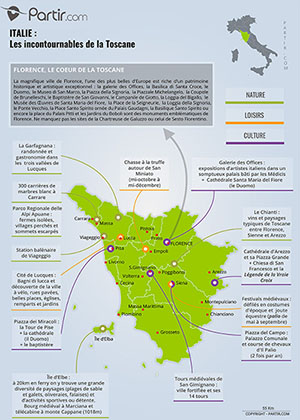Florence: 12 must-see attractions
Tourist attractions
What is there to see in Florence?

Giardino di Boboli
This remarkable Italian-style garden, behind Pitti Palace, is a real fairytale with its water games, fountains, ponds, amphitheater and statues ... Don't miss the Kaffehaus , with its rare rococo-style architecture, so typical of the Tuscany region, or the surprising Buontalenti Cave (late 16th century), with its artificial concretions similar to stalactites and stalagmites. Everywhere you look there is lush vegetation and tall cypress trees, a scene so typical in the Tuscany region. Wandering through the narrow streets in summer is a real delight, and a perfect way to escape the stifling heat of the city.
Heritage | Art & Culture | Architecture | Gardens
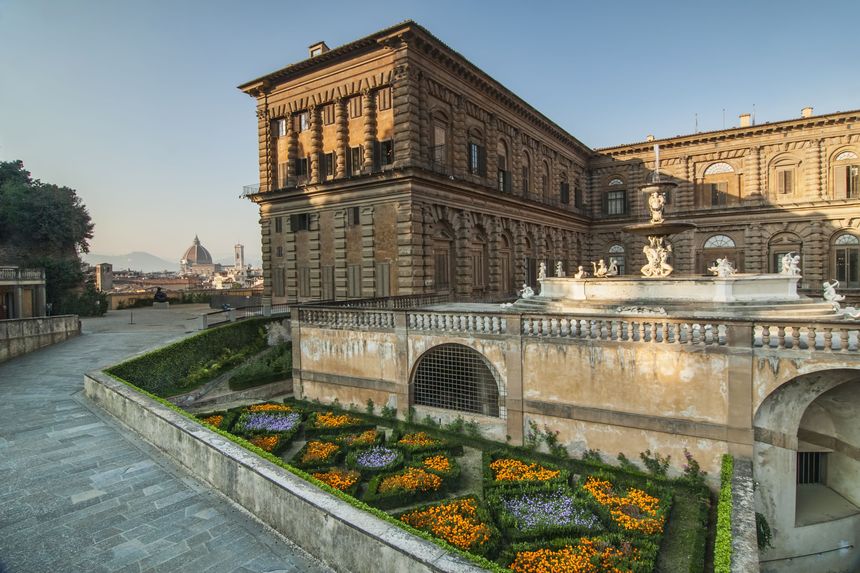
Pitti Palace
In 1550, the largest palace in Florence was bought by Eleanor of Toledo, the wife of Cosimo I de' Medici, who wanted to settle in a palace worthy of the Grand Duchy. She hoped that Oltrarno, on the left bank, would be able to offer a healthier environment and fresher air than that of Palazzo Vecchio, in the main town. Pitti Palace was built around 1440 for a Florentine banker, Luca Pitti, hence its name. Extended on the garden side by Amannati, in 1560, then again in the 17th century, the palace has a long and slightly austere façade (more than 200 m) which conceals a number of splendid royal apartments. After becoming the official residence of the Grand Duchy of Tuscany from Ferdinand I, the palace fell into the hands of the Houses of Lorraine and Savoy before being occupied briefly by King Victor Emmanuel II, when Florence was the capital of the kingdom of Italy.
Pitti Palace is home to several museums, including the Palatine Gallery, with dazzling collections of paintings (from Italian masters such as Raphael, Titian, Caravaggio ... and foreign artists such as Rubens, Van Dyck, Velasquez etc.), the Museum of Costume and Fashion, and the Gallery of Modern Art.
Heritage | Art & Culture | Architecture | Monuments | Museums
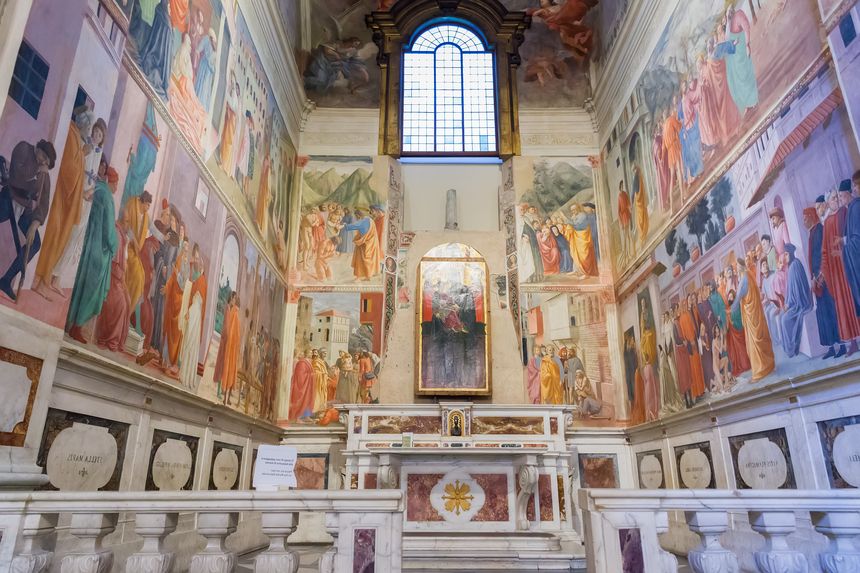
Cappella Brancacci
Another jewel of the Renaissance in a city overflowing with masterpieces! This chapel, located on the right transept of Santa Maria del Carmine church, is decorated with frescoes illustrating the life of Saint Pierre and the original sin. While they were ordered from Masolino da Panicale, by Felice Brancacci (1423), a rich silk merchant, they were mainly produced by Masaccio between 1424 and 1428, and Filippino Lippi (1481-83). The most famous paintings are probably the expulsion of Adam and Eve from Paradise, The Baptism of the Neophytes and the Tribute Money, portraying the life of Saint Peter, in which Masaccio's character illustrations excel in their realism, dramatic expressions and posture depiction . As a modern painter, Masaccio, who died very young, remains one of the most innovative artists of the first Italian Renaissance.
Heritage | Art & Culture | Architecture | Monuments | Museums
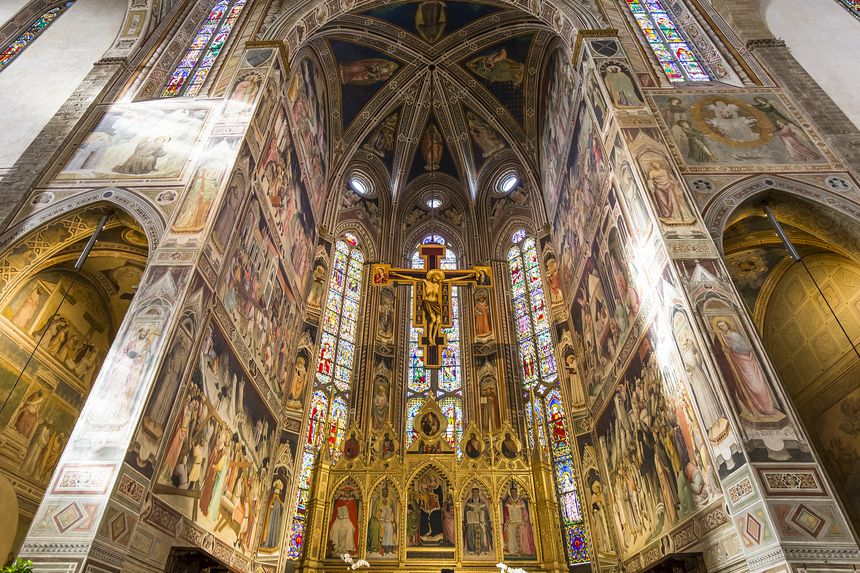
Santa Croce
Santa Croce is to the greatest Italian artists what San Lorenzo is to the Medici: a real pantheon. As the largest Franciscan church in the world, it is also the burial place for, amongst others, Ghiberti, Michelangelo, Vasari, Galileo, Machiavelli, Rossini, etc. Started in 1294 by Arnolfo del Cambio, the church was completed in the 16th century, but its facade three centuries later! The most renowned Florentine families financed the construction of this sanctuary, demanding, in return, to have a chapel sumptuously decorated in their name. Santa Croce is therefore home to some of the most significant Florentine paintings of the 16th century: Baroncelli chapel (Life of the Virgin by Taddeo Gaddi); Castellani chapel (Stories of Saints by Agnolo Gaddi); main chapel (Legend of the True Cross, Agnolo Gaddi), Bardi chapel and Peruzzi chapel (Giotto, although unfortunately the frescoes from the eighteenth century have been poorly restored) ... Don't miss the gigantic wooden crucifix by Cimabue ( late thirteenth century), restored after the terrible Arno flood in 1966, and the Pazzi Brunelleschi chapel (access to the right of the church).
Heritage | Art & Culture | Architecture | Monuments

Basilica di San Lorenzo
The real Medici sanctuary. In 1418, Giovanni di Bicci, the Medici family patriarch, entrusted the construction to Brunelleschi from which rose, according to tradition, the first cathedral of Florence (393). The architect also designed the Old Sacristy , a pure gem from the Renaissance period and decorated by Donatello. In the following century, Pope Leo X, son of Lorenzo the Magnificent, called upon Michelangelo to complete the sanctuary which was still lacking a facade: while he failed to carry out this project, he did create the monumental New Sacristy and started the Laurentian Library , commissioned by Pope Clement VII (however, these two achievements were actually completed by his students as the master returned to Rome). In the end it was Cosme I who, in 1568, pushed forward plans for the Chapel of the Princes , a hard stone monumental mausoleum, built under the reign of Ferdinand I. As a symbol of their power, San Lorenzo hosted the dynasty's major events as well as state ceremonies. In building their mausoleum, the Medici appealed to some of the greatest artists of their time to build them tombs here (amongst others, Giuliano, Duke of Nemours, and Lorenzo, Duke of Urbino, fulfilled by Michelangelo).
Heritage | Art & Culture | Architecture | Monuments
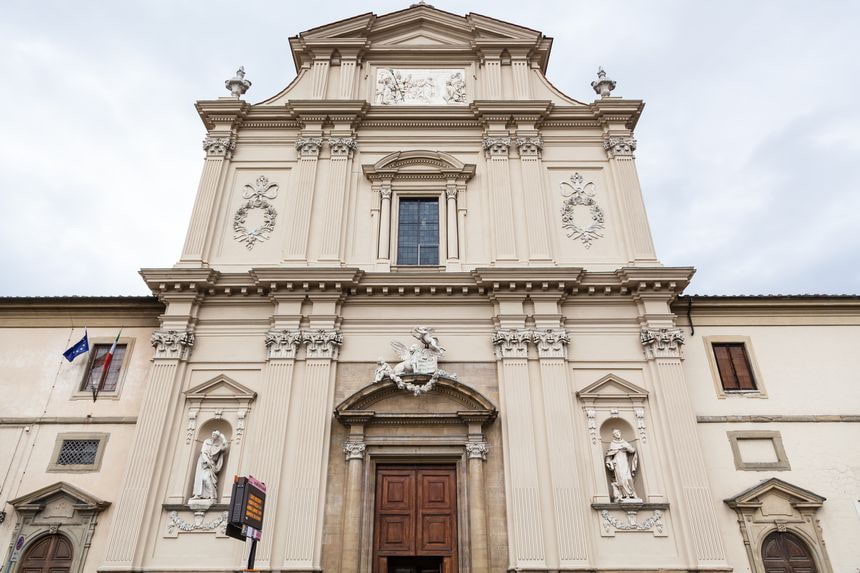
San Marco Museum
While the Accademia showcases the talent of Michelangelo, the Dominican convent of San Marco bears the mark of one of his most famous boarders, Fra Angelico (v. 1400-1455). At the request of Saint Antoninus, the Florentine monk adorned the site with a hundred or so frescoes, notably in the 43 cells of the brothers, depicting, in images, the life of Christ with modernity and sobriety. Also of interest is the 'Crucifixion with Saints found in the Convent’s Chapter House' fresco, 'The Annunciation', at the top of the staircase, the Renaissance painting masterpiece and 'The Last Judgment' in the Pilgrim's Hospice. The famous preacher, Savonarola, also lived in the convent (cells 12 to 14), as did St. Antoninus, the Archbishop of Florence in 1445 (cell 31). Cosimo the Elder, who financed the convent's works, also retreated here (cells 38-39). The few monks remaining had to leave in 2018 when the Dominican Order signed a decree to close the convent despite strong protests and an appeal to the pope.
Museums | Heritage | Art & Culture | Architecture | Monument
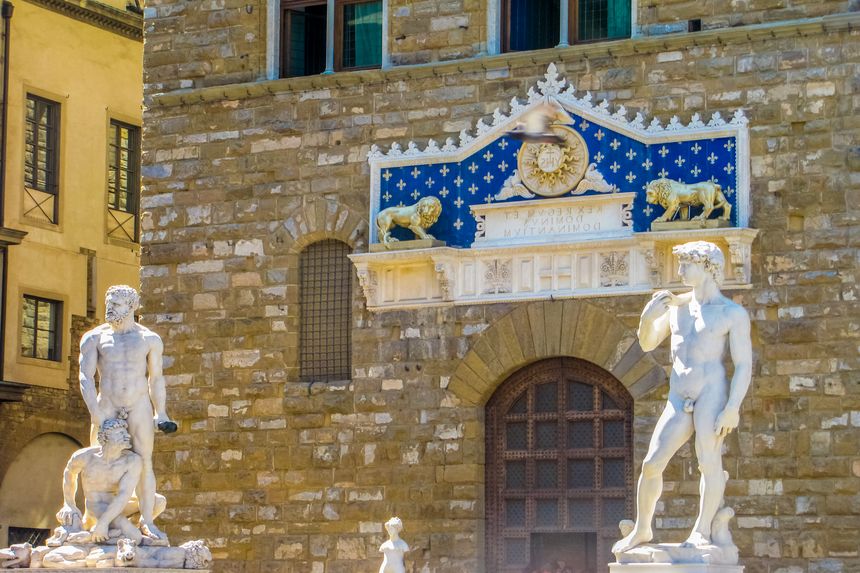
Accademia Gallery
Michelangelo feels at home here: not only was he proclaimed "father and master" of the arts at the first meeting of the Academy and Company of the Arts of Drawing, in January 1563, but the museum has kept some of his most beautiful sculptures. Firstly, probably the most famous statue in the world, the one to which all eyes turn towards: the powerful 'David' (1504) symbolizing the strength and independence of the Florentines, initially erected in front of the Palazzo Vecchio until 1873. After witnessing his early work for yourself, take a look at his later and more mature works, whose bodies seem to want to burst out of the marble they are carved into: the striking 'Pietà' and the disturbing 'Unfinished Slaves' who were meant to decorate the tomb of Pope Julius II. In addition to sculptures by other great artists, make sure you also make time for the gypsotheca and collection of Florentine paintings from the 13th to 16th centuries.
Art & Culture | Heritage | Musée | Architecture | Monument

Basilica di Santa Maria Novella
One of Florence's major churches, built by the Dominicans from 1279, with a spectacular Renaissance facade in green and white polychrome marble, the work of arts and architecture theorist, Leon Battista Alberti (1404-1472). The sanctuary contains masterpieces from the Quattrocento period: the Holy Trinity by Masaccio (1427, in the nave), who was the first to apply the rules of perspective to painting; frescoes by Ghirlandaio (1485-1490, in the Tornabuoni chapel behind the main altar), which perfectly depict Florentine life of the time; frescoes by Paolo Uccello (1430, Chiostro Verde), which unfortunately are very damaged, ... And let's not forget the gigantic Crucifix by Giotto (1288-1289), in the centre of the nave, painted on wood and representing a dying Christ.
Art & Culture | Monuments | Heritage
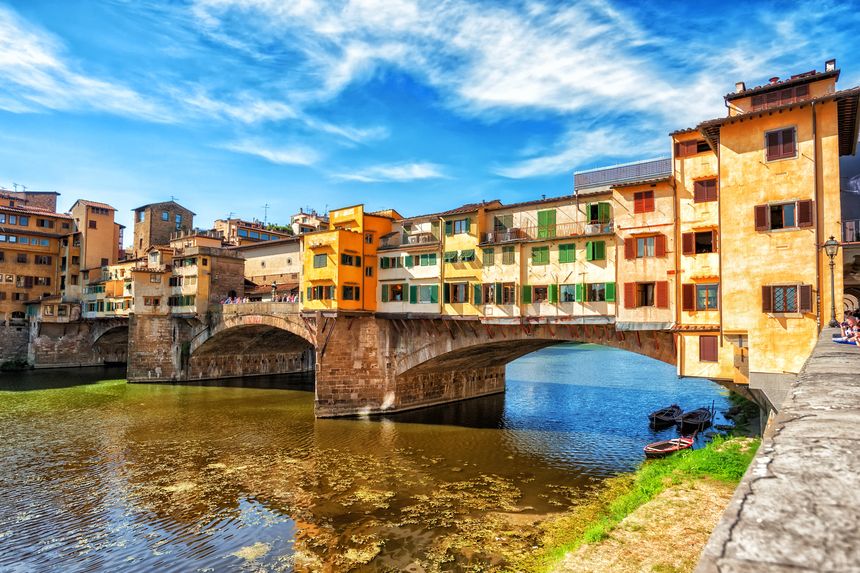
Ponte Vecchio
It's impossible to ignore this iconic Florence Bridge, even though the constant flow of tourists is enough to put off even the most determined onlookers. The bridge was rebuilt in 1345 after being swept away by a flood and is famous for its corbelled houses, home to jewellers and goldsmiths. However, it was nearly washed away by the Flood of the Arno, which took place on 4th November, 1966, and destroyed all the Ponte Vecchio shops, and infiltrated the basements of the Uffizi, the National Library and many more national monuments. The flood devastated the city and left it under a layer of mud.
In 1565, Vasari designed a private passageway, called the Vasari Corridor, between Palazzo Vecchio and Palazzo Pitti so that Cosimo I could pass safely between the two without having to mingle with the crowds outside. One kilometre long, the Corridor displays a collection of self-portraits, but is very rarely open to visitors.
Monuments | Architecture | Heritage
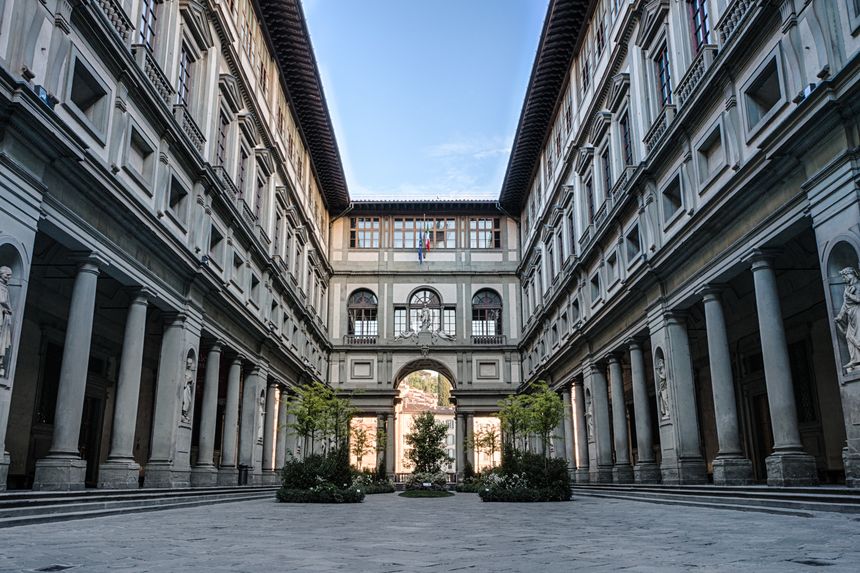
Uffizi Gallery
One of the most prestigious museums in the world, offering a remarkable display of Italian paintings from the 17th and 18th centuries, not forgetting those from other European schools (mainly Flemish and German). It was built by Vasari from 1560, and designed to serve as offices for Cosimo de' Medici's administration. It was his son, Francesco I de' Medici, the Grand Duke of Tuscany, who turned it into a gallery for his own personal collections. It's impossible to mention all the masterpieces that are preserved here, but for a first visit you simply must see the Italian primitive collections, in particular the Virgin and Child works of art by Cimabue and Duccio, as well as those of the Renaissance masters, such as Paolo Uccello, Piero della Francesca, Raphael, Michelangelo, Leonardo da Vinci and, of course, Botticelli, whose 'Birth of Venus' and 'Spring' paintings are the real stars of the gallery.
Museums | Heritage | Monuments | Art & Culture | Architecture
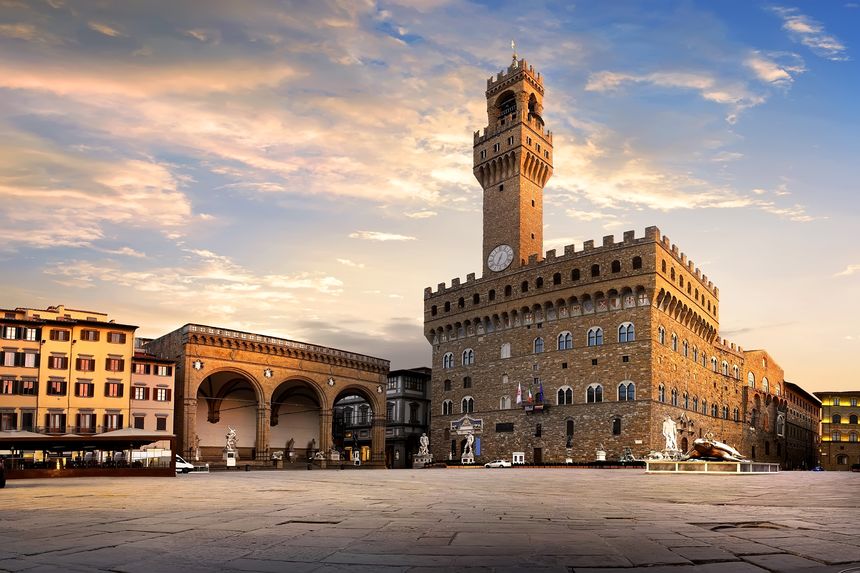
Piazza della Signoria
Here stands the Palazzo Vecchio , centre of political and civil power from the 13th century onwards and seat of the city's government (Signoria) from 1540 to 1565 before the Medici took power, when they were required to transfer to the Palazzo Pitti, on the other side of the Arno river. With a rather austere fortress-like exterior, the interior is richly decorated by Giorgio Vasari to the glory of Cosimo I: the Hall of the Five Hundred, with its coffered ceiling adorned in the centre with an Apotheosis of Cosimo I, and frescoes illustrating the victories of Florence over Pisa and Siena. Don't miss the Studiolo, a small work studio that belonged to Francesco di Medici, with paintings reminding us of his love for alchemy. Next to the Palazzo Vecchio, the Loggia dei Lanzi , which used to host public ceremonies, is a kind of outdoor sculpture museum and includes the statue of 'Perseus' by Cellini.
Heritage | Monuments | Art & Culture
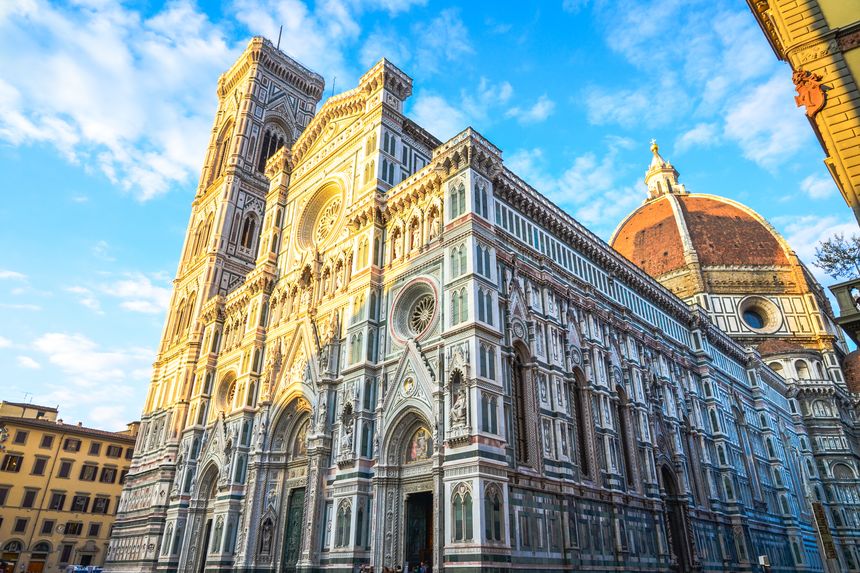
Piazza del Duomo
With its gigantic tile-covered dome and polychrome geometric pattern adorning its white walls, inlaid with green marble, the Duomo (or Santa Maria del Fiore Cathedral) imposes a majestic silhouette on the Florentine skyline ... Brunelleschi, the genius architect who raised the dome in 1434, wanted it to overshadow those of Pisa and Siena, the two main rivals of the fleur-de-lys city. The cathedral's construction started in 1296 and occupies the site of an old church. Next to it is the bell tower designed by Giotto which is also covered in polychrome marble. Opposite the Duomo is the octagonal baptistery, probably the oldest building in the city and dedicated to the patron saint of Florence, John the Baptist. Also covered in white and green marble, it is adorned with three bronze doors, masterpieces of Renaissance sculpture. That to the south was carved by Andrea Pisano (1330-1336) to the glory of St. John the Baptist; the other two are the work of Lorenzo Ghiberti (1403-1428). On the north door are illustrations from the New Testament, while the eastern door, known as the "door of Paradise", is dedicated to the Old Testament. The originals are kept at the Museo dell'Opera del Duomo, also on the square.
Monuments | Heritage | Architecture | Museums | Art & Culture
You may also like
-
Flights to Tuscany
All you need to know before buying your plane ticket
-
Tourist maps
Region, attractions and distance map Tuscany!
-
Hotel or vacation rental?
Find your dream accommodation in Tuscany at the best price...
-
When to go?
Be sure to visit Tuscany at the best time of year!
and why not...
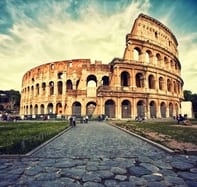 Roma and Latium
Roma and Latium


